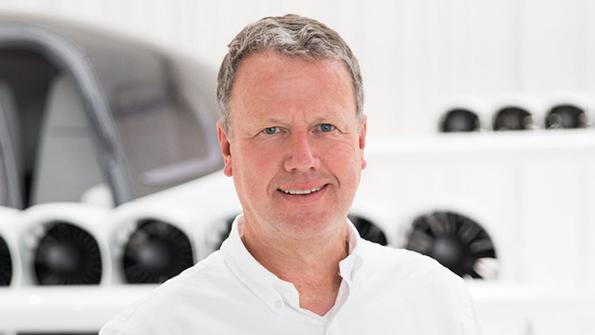
Klaus Roewe
A former Airbus executive who once oversaw the A320 family program, Roewe now heads Lilium, a German startup aiming to certify its ducted-fan, electric vertical-takeoff-and-landing (eVTOL) Lilium Jet. In a recent conversation with Aviation Week editors, he provided an update on the company’s finances and the path to certification. Excerpts follow.
Lilium recently pivoted to focus on launching first in the private aviation market. What was the reason for the shift? Our agreement with NetJets made us think there could be an opportunity there, and we quickly got a big response from private buyers. It’s a good market because the yields are higher, so the willingness to pay is higher. Those wealthy buyers are not looking for a workhorse; they’re looking for comfort, differentiation and safety. And they want not only [aircraft], but a solution that includes maintenance and services—so they’re willing to pay more upfront. It’s also a great opportunity to get money into Lilium. We get more money, and we get it faster. On top of that, having famous or wealthy people flying our aircraft is a big plus from a marketing standpoint. So we think this is a great approach in terms of early cash flows, marketing, having ambassadors and making full use of the capabilities of our [aircraft].
The Lilium Jet’s practical operating range has been reduced to around 175 km (109 mi.). Does it still make sense to think of the aircraft as a regional mobility platform? Absolutely. When you look at the potential air shuttle applications in terms of city pairs, what we find is we can fly basically the whole of Florida. [That] is where we plan to build out our first regional network in the U.S. But even here in Germany, if we look at Munich, we see plenty of connections to cities and potential demand from hundreds of thousands of people who can afford flying. And this is just with our current carbon battery at type certification in less than three years. But it’s also important to remember that battery generations take about five years, and the next generation is going to take us much further. To be sure, eVTOLs don’t make much sense beyond 400-500 km. But if we wanted to go 400 km or more, we would need less than two battery generations to get there. The Lilium Jet was designed to be ultra-efficient in cruise, so with every 10% improvement in battery capacity we get a 20% increase in range. So when we look at future battery generations, we will be close to 300 km by 2030 and 400 km by the generation after that.
Recent securities filings indicate that Lilium needs to raise an additional $540 million to close a funding gap. How challenging will it be to raise that much? At a quick glance, we don’t get to type certification with our current cash levels, and that’s obvious. However, we do already have some customers with firm orders making down payments, so that will help. But putting that aside, we do need to raise further funds. So what do we do? We’re still looking at the private capital markets, but they’re not great at the moment. We are also considering other options like finding strategic partners that can not only invest in the company, but also bring assets from other industries like automotive. We are actually in advanced talks with potential partners, but I cannot disclose more information at this time.
What other options are there? We are also in very advanced discussions regarding public funding. We don’t try to take hidden subsidies through defense budgets and stuff like that; we have gone in full transparency to the governments in Bavaria [in] Germany and Europe. Additionally, we are in talks with our shareholders—most of whom have signaled their intent to invest further. So if you were to ask me what my confidence level is that our financing problem will be resolved, I would say 100%. And I’m confident that we have more news coming that will surprise the people who are criticizing our financial runway.
How confident are you about entry into service in 2025? I’m 100% confident in 2025. When I look at how we have shaped our schedule with regard to closing out the design, we really left no stones unturned. Our preliminary design review that we closed was very robust, so there have been no changes to the [aircraft] in quite a while. We have secured around 77% of our suppliers under contract, including all the major parts, so nothing stands in the way of starting assembly by the end of the year. And then we have basically two years to complete the first aircraft in final assembly and conduct the ground test and all the flight testing. The aircraft is fairly simple compared to our competitors,’ and we have a year and a half more to fly our [prototype] Phoenix before we get to the [production-conforming] Pegasus. So I don’t see a reason why we shouldn’t have a certified product by 2025.





